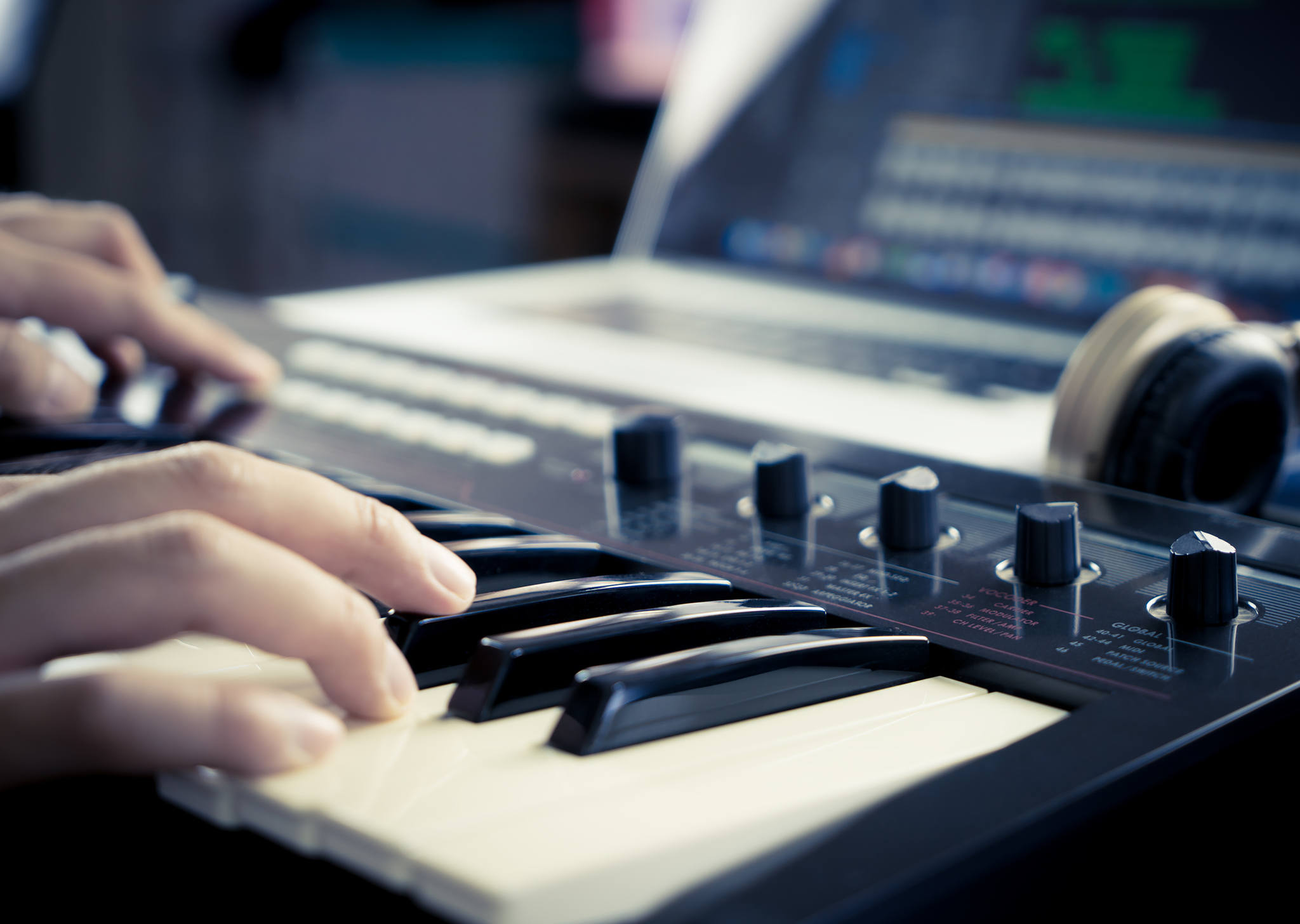When you envision taking piano lessons, what do you see? Many of us see the end product. We see ourselves playing a solo in front of thousands of people or playing keys in a popular band. We see ourselves playing in a studio or at a restaurant’s dinner hour.
While many of us shoot for similar goals, the road each of us takes to get there is a bit different. With this in mind, I have created different pathways from which my students can choose as they move toward their goals.
I call these pathways “tracks”. Take a look and see what they are all about.
Chords Track
Prerequisite: Piano 1-2
45 or 60-minute Lesson Required
The Chords Track focuses on teaching you to play pop, rock, and jazz tunes, and the chords and chord progressions associated with each style. You will learn to read chord symbols, chord charts, lead sheets, and slash charts.
Chord technique, such as right and lefthand rhythmic patterns, incorporating the melody, utilizing chord inversions, chord abbreviations, chord coloring, and learning to play accompaniment are also taught.
Students who take the Chords Track will learn how to transpose songs using the Nashville Numbering System (NNS).
Songwriting Track
Prerequisite: Piano 1-2 and Chords 1-2
45 or 60-minute Lesson Required

In the Songwriting Track, you will learn many of the essential ingredients of a great song including song structure, using technology to capture and harness ideas, the fundamentals of lyric writing, writing great melodies, instrumentation, and how to write for specific instruments, modulation, and countermelodies.
Songwriting is close to my heart as I have been writing music since I was a kid. This past summer I recorded an original solo piano album Perfect Peace called I have also written more than 100 worship songs.
In this track, I share with you everything you need to know about songwriting based on my personal journey with writing and the songs of some of the greatest songwriters in history.
Music Theory Track
Prerequisite: Piano 1-4
45 or 60-minute Lesson Required
Just as a spoken language has rules that govern it, so does the language of music. This language helps us understand how music works, and it gives us the terminology to communicate with other musicians.
Show me a musician that knows music theory, and I will show you someone who can quickly make sense of the music they read and hear. The Music Theory Track goes beyond the typical music theory that a person gets when learning to play the piano.
In this track, you will learn about the make-up of chords and their functions, ear training exercises, modal scales and harmony, the hierarchy of 3rds and 7ths, and dominant function.
It’s everything you would ever need to know about how music works.
Piano Track
No Prerequisites Required
Any lesson package works
All of my students automatically begin with the Piano Track. This track includes learning to read notes, scales, arpeggios, as well as the classical piano literature by some of the greatest composers like Beethoven, Mozart, and Bach.
Once you complete the prerequisite modules in this track, you will then be given the option to add one of the other 3 tracks to your lessons.
Track Modules
Piano
Music Theory
Songwriting
Chords
Piano 1
Introduction to Playing
Black Keys
White Keys
Clefs and Staffs
Intervals, Slurs, and Ties
G Position
Crescendo and Diminuendo
Music Theory 1
Prerequisite: Piano 1-4
45 or 60-minute Lesson Required
1st & 2nd Inversions of Triads
Inversions of V7 Chords
Figured Bass
Major Chord Progressions
Minor Scales, Minor Triads
Augmented and Diminished Triads
Primary Triads in Minor Keys
Songwriting 1
Prerequisites: Piano 1-2, Chords 1-2
45 or 60-minute Lesson Required
The Power of Song
Inspiration and Craft
Starting Points
Using technology to harness and manage ideas
Conventional Song Structures
Unconventional Song Structures
Chords 1
Prerequisite: Piano 1-2
45 or 60-minute Lesson Required
Major & Minor Chords (C, G, F)
Chord Inversions (C, G, F)
Simple Chord Progressions
Simple Chord Rhythms
Piano 2
Incomplete measures
Tempo markings
Eighth notes and rests
Using the damper pedal
Half steps and whole steps
Major scale through the concept of tetrachords
Music Theory 2
Minor Chord Progressions
Modes
Harmonizing a Melody in Major and Minor Keys
Broken Chords and Arpeggiated Accompaniments
Passing and Neighbor Tones
Melody, Harmony, Rhythm, Texture Form
Songwriting 2
The Fundamentals of Lyric Writing
Rhyme and Meter
Writing a great hook (lyrical and musical)
Lyrics for the Verse, Chorus
Marrying the Music and Lyrics
Old Ideas in New Packages
Chords 2
Major and Minor Chords (D, A, E)
Chord Inversions (D, A, E)
Dominant 7 Chords
Minor 7 Chords
Piano 3
Dotted half notes
Dotted quarter notes
Intervals of 6ths, 7ths and octave
Crossing 2 over 1
Scale work
Triads
Primary Chords
Blocked and broken chords
Music Theory 3
Swing Feel & Eighth Notes
Swing Groove
Syncopy, Beebop Style
Lick, Line and Melodic Soloing
Ear training 1-5
Songwriting 3
How to Write a Leadsheet, Chord Chart, Slash Chart
How to Pick the Right Key, Tempo
Instrumentation: Guitars, Keys, Bass, Guitars, Drums, Strings, Brass
How to Write for Vocals
Chords 3
Major and Minor Chords (Eb, Ab, B)
Introduction to the Nashville Numbering System (NNS)
Augmented
Diminished/Diminished 7
Piano 4
Overlapping pedal
3/8 and 6/8 time
Primary triads: major & minor
Passing 1 under 2 & 3
Major scales in contrary motion
Chromatic scale
Minor scale
Music Theory 4
Major Triad, Scale, Consonance
Major Seventh chords
Chord Changes
Tonic Function, Scalar Melody
Dissonant 4th and Resolution
Ear Training 6-9
Songwriting 4
Melodic Function and Development
Voice Leading
Passing Chords
Counter Melodies
Modulation: Common Tone, 3rd Relationship, II – V – I
Chords 4
More about the NNS
Transposition
Secondary Dominant
Half-Diminished
Piano 5
Tarantellas
Eighth note triplets
Arpeggiated chords
1st & 2nd inversion triads in all keys
Major scales in parallel motion
Two-part writing
Music Theory 5
Subdominant Major Seventh Chords
Voice Leading Tonic & Subdominant
Modes, Lydian Scale
Hierarchy of 3rds & 7ths
Ear Training 10-13
Major 9th Chords
Major 6/9
Major Pentatonic Scale
Grace Notes, Scoops & Turns
Ear Training 14-17
Songwriting 5
The Basics of Music Writing Software
MIDI
Recording Your Songs
Copyrighting Your Songs
Getting Your Songs Online
Marketing Your Songs
Chords 5
2, 4, 6 Chords
9, 11, 13 Chords
b9, #9, +11 Chords
Minor/Major 7 Chords
Piano 6
7th chords & inversions
E harmonic minor scale in contrary motion
Primary chords in E minor
Sixteenth notes
Dotted eighth notes
Primary chords in B-flat Major and G Minor
Repeated-note warm-ups
Harmonic minor scales in parallel motion
Music Theory 6
Dominant 7 & 9 Chords
Dominant Function
Resolution of V7 Chords, Tendency Tones & Tritones
Common Tones and Voice Leading
Mixolydian, Bebop Dominiant Scale
Ear Training 18-22
Piano 7
Long appoggiatura
Short appoggiatura
Trill and mordent
Arpeggios: A, B & C minor
Minuets
Sonatinas
Preludes
Arias
Music Theory 7
Bluesy Dominant Chords
Blue Notes
Blue Notes
12 Bar Blues Progression
Ear Training 23-25
Piano 8
Diminished triads
Augmented triads
Diminished 7th chord
32nd notes
Dotted 16th notes
Classical Piano
Music Theory
Piano 1
Introduction to Playing
Black Keys
White Keys
Clefs and Staffs
Intervals, Slurs, and Ties
G Position
Crescendo and Diminuendo
Piano 2
Incomplete measures
Tempo markings
Eighth notes and rests
Using the damper pedal
Half steps and whole steps
Major scale through the concept of tetrachords
Piano 3
Dotted half notes
Dotted quarter notes
Intervals of 6ths, 7ths and octave
Crossing 2 over 1
Scale work
Triads
Primary Chords
Blocked and broken chords
Piano 4
Overlapping pedal
3/8 and 6/8 time
Primary triads: major & minor
Passing 1 under 2 & 3
Major scales in contrary motion
Chromatic scale
Minor scale
Piano 5
Tarantellas
Eighth note triplets
Arpeggiated chords
1st & 2nd inversion triads in all keys
Major scales in parallel motion
Two-part writing
Piano 6
7th chords & inversions
E harmonic minor scale in contrary motion
Primary chords in E minor
Sixteenth notes
Dotted eighth notes
Primary chords in B-flat Major and G Minor
Repeated-note warm-ups
Harmonic minor scales in parallel motion
Piano 7
Long appoggiatura
Short appoggiatura
Trill and mordent
Arpeggios: A, B & C minor
Minuets
Sonatinas
Preludes
Arias
Piano 8
Diminished triads
Augmented triads
Diminished 7th chord
32nd notes
Dotted 16th notes
Music Theory 1
Prerequisite: Piano 1-4
1st & 2nd Inversions of Triads
Inversions of V7 Chords
Figured Bass
Major Chord Progressions
Minor Scales, Minor Triads
Augmented and Diminished Triads
Primary Triads in Minor Keys
Music Theory 2
Minor Chord Progressions
Modes
Harmonizing a Melody in Major and Minor Keys
Broken Chords and Arpeggiated Accompaniments
Passing and Neighbor Tones
Melody, Harmony, Rhythm, Texture Form
Music Theory 3
Swing Feel & Eighth Notes
Swing Groove
Syncopy, Beebop Style
Lick, Line and Melodic Soloing
Ear training 1-5
Music Theory 4
Major Triad, Scale, Consonance
Major Seventh chords
Chord Changes
Tonic Function, Scalar Melody
Dissonant 4th and Resolution
Ear Training 6-9
Music Theory 5
Subdominant Major Seventh Chords
Voice Leading Tonic & Subdominant
Modes, Lydian Scale
Hierarchy of 3rds & 7ths
Ear Training 10-13
Major 9th Chords
Major 6/9
Major Pentatonic Scale
Grace Notes, Scoops & Turns
Ear Training 14-17
Music Theory 6
Dominant 7 & 9 Chords
Dominant Function
Resolution of V7 Chords, Tendency Tones & Tritones
Common Tones and Voice Leading
Mixolydian, Bebop Dominiant Scale
Ear Training 18-22
Music Theory 7
Bluesy Dominant Chords
Blue Notes
Blue Notes
12 Bar Blues Progression
Ear Training 23-25
Songwriting
Chords
Songwriting 1
Prerequisites: Piano 1-2, Chords 1-2
The Power of Song
Inspiration and Craft
Starting Points
Using technology to harness and manage ideas
Conventional Song Structures
Unconventional Song Structures
Songwriting 2
The Fundamentals of Lyric Writing
Rhyme and Meter
Writing a great hook (lyrical and musical)
Songwriting 3
The Fundamentals of Lyric Writing
Rhyme and Meter
Writing a great hook (lyrical and musical)
Songwriting 4
Instrumentation
Writing for Guitars
Writing for Keys
Writing for Vocals
Songwriting 5
Arranging
Counter Melodies
Key Changes: traditional, 3rd relationship, common tone, diminished
Chords 1
Prerequisite: Piano 1-2
Major & Minor Chords (C, G, F)
Chord Inversions (C, G, F)
Simple Chord Progressions
Simple Chord Rhythms
Chords 2
Major and Minor Chords (D, A, E)
Chord Inversions (D, A, E)
Dominant 7 Chords
Minor 7 Chords
Chords 3
Major and Minor Chords (Eb, Ab, B)
Introduction to the Nashville Numbering System (NNS)
Augmented
Diminished/Diminished 7
Chords 4
More about the NNS
Transposition
Secondary Dominant
Half-Diminished
Chords 5
2, 4, 6 Chords
9, 11, 13 Chords
b9, #9, +11 Chords
Minor/Major 7 Chords
Piano
Piano 1
Introduction to Playing
Black Keys
White Keys
Clefs and Staffs
Intervals, Slurs, and Ties
G Position
Crescendo and Diminuendo
Piano 2
Incomplete measures
Tempo markings
Eighth notes and rests
Using the damper pedal
Half steps and whole steps
Major scale through the concept of tetrachords
Piano 3
Dotted half notes
Dotted quarter notes
Intervals of 6ths, 7ths and octave
Crossing 2 over 1
Scale work
Triads
Primary Chords
Blocked and broken chords
Piano 4
Overlapping pedal
3/8 and 6/8 time
Primary triads: major & minor
Passing 1 under 2 & 3
Major scales in contrary motion
Chromatic scale
Minor scale
Piano 5
Tarantellas
Eighth note triplets
Arpeggiated chords
1st & 2nd inversion triads in all keys
Major scales in parallel motion
Two-part writing
Piano 6
7th chords & inversions
E harmonic minor scale in contrary motion
Primary chords in E minor
Sixteenth notes
Dotted eighth notes
Primary chords in B-flat Major and G Minor
Repeated-note warm-ups
Harmonic minor scales in parallel motion
Piano 7
Long appoggiatura
Short appoggiatura
Trill and mordent
Arpeggios: A, B & C minor
Minuets
Sonatinas
Preludes
Arias
Piano 8
Diminished triads
Augmented triads
Diminished 7th chord
32nd notes
Dotted 16th notes
Music Theory
Music Theory 1
Prerequisite: Piano 1-4
1st & 2nd Inversions of Triads
Inversions of V7 Chords
Figured Bass
Major Chord Progressions
Minor Scales, Minor Triads
Augmented and Diminished Triads
Primary Triads in Minor Keys
Music Theory 2
Minor Chord Progressions
Modes
Harmonizing a Melody in Major and Minor Keys
Broken Chords and Arpeggiated Accompaniments
Passing and Neighbor Tones
Melody, Harmony, Rhythm, Texture Form
Music Theory 3
Swing Feel & Eighth Notes
Swing Groove
Syncopy, Beebop Style
Lick, Line and Melodic Soloing
Ear training 1-5
Music Theory 4
Major Triad, Scale, Consonance
Major Seventh chords
Chord Changes
Tonic Function, Scalar Melody
Dissonant 4th and Resolution
Ear Training 6-9
Music Theory 5
Subdominant Major Seventh Chords
Voice Leading Tonic & Subdominant
Modes, Lydian Scale
Hierarchy of 3rds & 7ths
Ear Training 10-13
Major 9th Chords
Major 6/9
Major Pentatonic Scale
Grace Notes, Scoops & Turns
Ear Training 14-17
Music Theory 6
Dominant 7 & 9 Chords
Dominant Function
Resolution of V7 Chords, Tendency Tones & Tritones
Common Tones and Voice Leading
Mixolydian, Bebop Dominiant Scale
Ear Training 18-22
Music Theory 7
Bluesy Dominant Chords
Blue Notes
Blue Notes
12 Bar Blues Progression
Ear Training 23-25
Chords
Chords 1
Prerequisite: Piano 1-2
Major & Minor Chords (C, G, F)
Chord Inversions (C, G, F)
Simple Chord Progressions
Simple Chord Rhythms
Chords 2
Major and Minor Chords (D, A, E)
Chord Inversions (D, A, E)
Dominant 7 Chords
Minor 7 Chords
Chords 3
Major and Minor Chords (Eb, Ab, B)
Introduction to the Nashville Numbering System (NNS)
Augmented
Diminished/Diminished 7
Chords 4
More about the NNS
Transposition
Secondary Dominant
Half-Diminished
Chords 5
2, 4, 6 Chords
9, 11, 13 Chords
b9, #9, +11 Chords
Minor/Major 7 Chords
Songwriting
Songwriting 1
Prerequisites: Piano 1-2, Chords 1-2
The Power of Song
Inspiration and Craft
Starting Points
Using technology to harness and manage ideas
Conventional Song Structures
Unconventional Song Structures
Songwriting 2
The Fundamentals of Lyric Writing
Rhyme and Meter
Writing a great hook (lyrical and musical)
Songwriting 3
The Fundamentals of Lyric Writing
Rhyme and Meter
Writing a great hook (lyrical and musical)
Songwriting 4
Instrumentation
Writing for Guitars
Writing for Keys
Writing for Vocals
Songwriting 5
Arranging
Counter Melodies
Key Changes: traditional, 3rd relationship, common tone, diminished
![]()
![]()
![]()
![]()
![]()
“I loved taking piano lessons with Ken! He is familiar with a myriad of styles and equipped me to compose music and learn quickly. He plays the piano with ease and is extremely knowledgeable.”
![]()
![]()
![]()
![]()
![]()
“Ken is a great instructor. He is incredibly brilliant with music theory and instrumentation, yet is able to keep lessons at a pace that is congruent with any level that you’re at. Highly recommend!”



